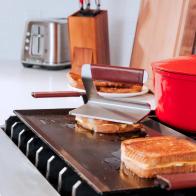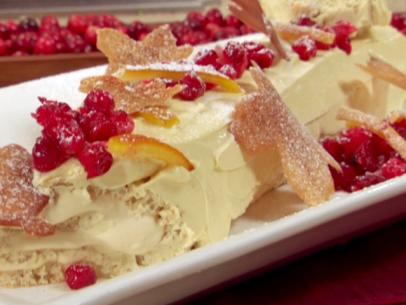
Recipe courtesy of Zachary Golper
Recipe courtesy of Zachary Golper
Watch how to make this recipe.
White Pullman Loaf (Pain de Mie)
Getting reviews...
- Level: Intermediate
- Total: 15 hr
- Active: 40 min
- Yield: 12 servings
-
- Nutritional Analysis
- Per Serving
- Serving Size
- 1 of 16 servings
- Calories
- 317
- Total Fat
- 5 g
- Saturated Fat
- 2 g
- Carbohydrates
- 58 g
- Dietary Fiber
- 2 g
- Sugar
- 4 g
- Protein
- 9 g
- Cholesterol
- 42 mg
- Sodium
- 226 mg
You'll never buy supermarket bread again after trying this homemade white bread. Using "enriched dough" (one with milk and eggs) gives this loaf a delicious flavor and velvety soft crumb. (For baking, accurate metric measurements produce the best results, so we recommend using a digital scale for this recipe.)
- Level: Intermediate
- Total: 15 hr
- Active: 40 min
- Yield: 12 servings
-
- Nutritional Analysis
- Per Serving
- Serving Size
- 1 of 16 servings
- Calories
- 317
- Total Fat
- 5 g
- Saturated Fat
- 2 g
- Carbohydrates
- 58 g
- Dietary Fiber
- 2 g
- Sugar
- 4 g
- Protein
- 9 g
- Cholesterol
- 42 mg
- Sodium
- 226 mg
Ingredients
Starter
Dough
Dusting Flour
Directions
- Starter: Also called pre-ferment, pâte fermentée (a mature pre-ferment, as in this starter), or poolish (which contains commercial yeast, as in this starter), this is the leavening or rising component of the bread baking process. Turn on a digital scale and weigh your empty container. Deduct the weight of the container by pressing the "tare" function, which resets the scale to zero. Add milk to the container, and tare to zero again. Then, continuing to weigh the ingredients, add salt, pinch of yeast, sugar, and flour. Use a chopstick to stir the starter until the dry and wet ingredients are just mixed. Cover with plastic wrap and let rest at room temperature, away from direct sunlight, 6–8 hours.
- Dough: Stir flour, sugar, yeast, and salt in a medium bowl, and set aside. Pour milk into the pre-ferment to loosen it. Whisk 2 eggs in a large bowl; then stir in the pre-ferment/milk mixture. Use a rubber spatula to break up the pre-ferment into the liquid. Add the flour mixture and the butter, and continue mixing until most of the dry ingredients have been combined with the starter mixture. Using a wooden spoon, and starting in the middle of the bowl, slowly stir to the edges until most of the flour has been mixed in and hydrated.
- Roll and Tuck: A technique to develop gluten in the dough so it becomes firmer and easier to work with. This is done one time, followed by a resting period. Combine 1 part fine semolina with 5 parts unbleached white flour to make dusting flour, and lightly dust a clean work surface. Using a plastic bowl scraper, push the dough and residual flour out of the bowl onto the work surface. Use the scraper to stretch and gently shape the dough into a rough rectangle (dough will still be sticky). Then, starting at one end, roll and tuck the dough like a tube, about 3-4 times. Flip the dough so it’s seam-side up and flatten again to a rectangle in the opposite direction, so the seam stretches from left to right. Repeat rolling and tucking, always returning to a seam-up position. Continue until the dough feels stronger and begins to resist any further rolling, about 10 times. All of the flour will get absorbed into the dough during this process. Shape into a ball and place into a bowl coated with nonstick spray. Cover with plastic wrap and let rest at room temperature, 45 minutes.
- Stretch and Fold: This technique strengthens the dough by folding it over onto itself. This process is repeated 3 times, with a resting period after each stretch and fold. Lightly dust the work surface and your hands with dusting flour. Using the scraper, release the dough from the bowl and place it seam-side down on the work surface. Gently shape into a rectangle, then fold the dough into thirds, like a letter. Pat it down slightly, then repeat the same fold in the other direction. Place the dough back in the bowl, cover with plastic wrap and let rest at room temperature, 45 minutes. For the second stretch and fold, repeat the steps for the first stretch and fold, but this time stretch the dough by flipping back and forth (like pizza dough). Gently reshape it into a rough rectangular shape before folding. Cover with plastic wrap and rest at room temperature, 45 minutes. For the third and final stretch and fold, repeat the steps for the second stretch and fold, cover with plastic wrap and rest at room temperature, 45 minutes.
- Shaping/Fermentation (Proofing): Shape the dough to prepare it for baking, then ferment (proof) it for a period of time to expand the dough and develop flavor. Spray the bottom and sides of a pullman loaf pan with nonstick spray. Lightly dust the work surface and your hands with dusting flour. Press the dough down slightly to de-gas it, then stretch into a 16-inch square (or to whatever length of the pan you’re using). Roll the square into a tube. Place the tube seam side down into the prepared pan. Gently tap the dough down with your fist to even it out in the pan, then cover with plastic wrap. Let rest at room temperature until the dough rises about 1½ -inches above the surface of the pan, 1½–3 hours.
- Baking: Preheat oven to 425 degrees F (preferably convection). Test dough for baking by gently pressing; it should bounce back, leaving a slight dimple. Make an egg wash by whisking the remaining egg with a pinch of salt; add about 1 tablespoon of milk to thin it out. Spray the outer edges of the pan with nonstick spray and use a pastry brush to gently brush egg wash across the top of the dough, twice. (The spray will ensure the egg wash doesn’t seep into the corners of the pan.) Place in the oven and bake for 10 minutes. Lower temperature to 385 degrees F. Rotate the pan and bake an additional 12–15 minutes. Test for doneness by removing from oven and giving it a thump on top; it should sound hollow. Tap the pan on the counter to release the loaf; turn it over and carefully remove the bread from the pan. Return the loaf to the oven on its side, and bake directly on the rack to solidify the shape, 5 minutes.
- Cooling, Slicing, and Storing: Transfer bread to a cooling rack (and notice the caramel aroma!). Cool completely before slicing and eating, at least 2 hours. Store loosely in plastic for 7 days.
































